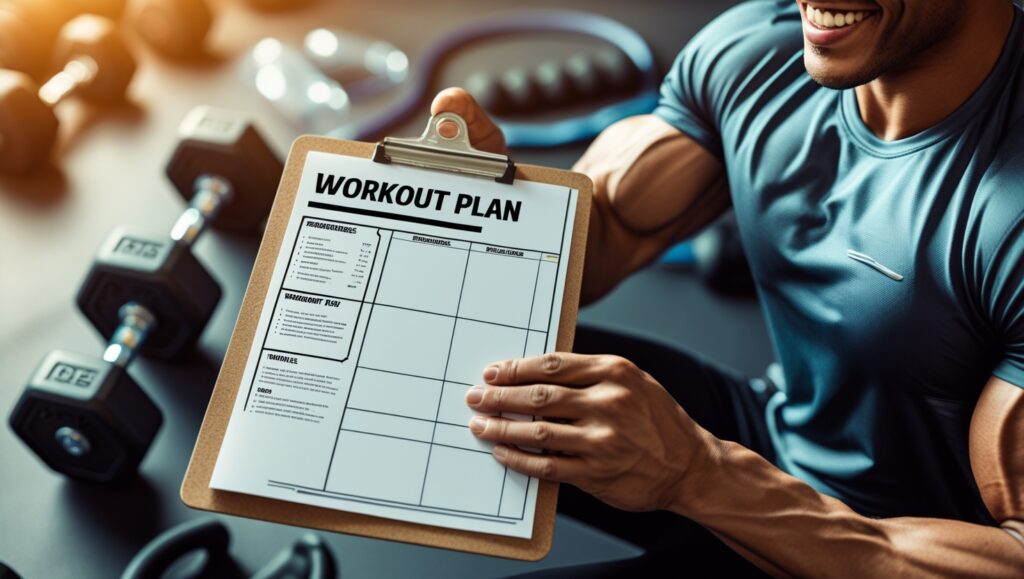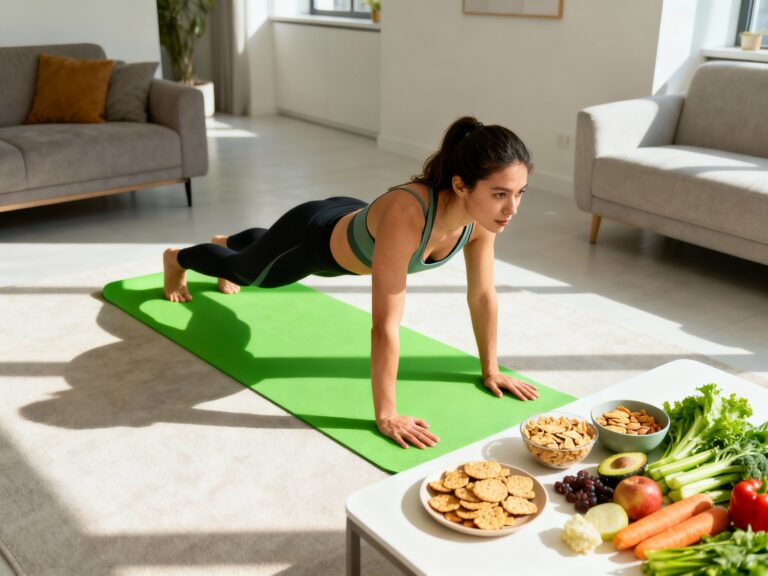How to Build a Workout Routine That Actually Works
Are you tired of starting workout routines only to lose motivation and see no results? Building an effective workout routine doesn’t have to be a daunting task. The key is to create a plan that fits your lifestyle, goals, and fitness level. With the right approach, you can design a routine that not only delivers results but also keeps you engaged and motivated. Let’s dive into how you can build a workout routine that actually works for you.

Key Takeaways
- A well-designed workout routine should align with your fitness goals and lifestyle.
- Consistency is crucial for seeing results, so make sure your routine is sustainable.
- Incorporate a mix of cardio, strength training, and flexibility exercises for overall fitness.
- Listen to your body and adjust your routine as needed to prevent injuries and burnout.
Understanding Your Fitness Goals
Before you start building a workout routine, it’s essential to define your fitness goals. Knowing what you want to achieve will help you create a targeted and effective plan.
What are Your Fitness Goals?
Defining your fitness goals helps you tailor your workouts to achieve specific outcomes. Common goals include:
- Weight Loss: Focus on calorie burning and metabolic boosting activities.
- Muscle Gain: Prioritize strength training with progressive overload.
- Improved Endurance: Emphasize cardio exercises with increasing intensity and duration.
- Overall Health: Incorporate a balanced mix of cardio, strength training, and flexibility exercises.
Setting Realistic Expectations
Realistic expectations are crucial for staying motivated and avoiding disappointment. Understand that progress takes time and consistency. Set achievable short-term goals that contribute to your long-term vision.
Assessing Your Current Fitness Level
Evaluating your current fitness level ensures that your workout routine is challenging yet manageable. This helps prevent injuries and burnout, ensuring a sustainable fitness journey.
Evaluating Your Physical Condition
Physical condition includes your strength, endurance, flexibility, and any existing physical limitations. Consider the following:
- Strength: How much weight can you lift comfortably?
- Endurance: How long can you perform cardio exercises without fatigue?
- Flexibility: How easily can you move through a full range of motion?
- Limitations: Are there any injuries or conditions that need special consideration?
Consulting with a Professional
If you’re unsure about your fitness level or have specific health concerns, consulting with a fitness professional can provide valuable guidance. A trainer can assess your condition and recommend a safe and effective workout routine.
Designing Your Weekly Workout Schedule
A well-structured weekly workout schedule balances different types of exercises to maximize results and prevent overtraining. Consistency is key, so create a schedule that fits your lifestyle and commitments.
Choosing the Right Types of Exercises
The right types of exercises depend on your fitness goals and preferences. Include a mix of cardio, strength training, and flexibility exercises for overall fitness.
- Cardio: Running, swimming, cycling, dancing
- Strength Training: Weightlifting, bodyweight exercises, resistance bands
- Flexibility: Stretching, yoga, Pilates
Structuring Your Weekly Schedule
Structuring your weekly schedule involves allocating specific days for different types of workouts. Here’s an example:
| Day | Activity | Focus |
|---|---|---|
| Monday | Strength Training | Upper Body |
| Tuesday | Cardio | Running |
| Wednesday | Rest or Active Recovery | Yoga or Stretching |
| Thursday | Strength Training | Lower Body |
| Friday | Cardio | Swimming |
| Weekend | Rest or Outdoor Activity | Hiking or Cycling |
Adjust this schedule based on your preferences and availability.

Essential Workout Tips
Implementing essential workout tips can enhance your results and prevent injuries. Proper form, progressive overload, and listening to your body are crucial for a successful workout routine.
Warm-Up and Cool-Down
Warm-up and cool-down routines prepare your body for exercise and promote recovery. Include dynamic stretches before workouts and static stretches after workouts.
Proper Form and Technique
Proper form and technique are essential for maximizing results and minimizing the risk of injuries. If you’re unsure about the correct form, seek guidance from a fitness professional.
Progressive Overload
Progressive overload involves gradually increasing the intensity, duration, or frequency of your workouts. This challenges your body and promotes continuous improvement.
Monitoring Your Progress
Tracking your progress keeps you motivated and helps you identify areas for improvement. Use a journal, app, or fitness tracker to monitor your workouts and results.
Keeping a Workout Journal
A workout journal allows you to record your exercises, sets, reps, and weights. This helps you track your progress and identify patterns or plateaus.
Measuring Your Results
Measuring your results provides tangible evidence of your progress. This can include tracking your weight, body measurements, strength gains, or endurance improvements.
Adjusting Your Routine as Needed
Adjusting your routine as needed ensures that your workouts remain challenging and effective. Modify your exercises, sets, reps, or frequency based on your progress and feedback.
Staying Motivated and Consistent
Maintaining motivation and consistency is crucial for achieving long-term fitness goals. Find ways to make your workouts enjoyable and incorporate them into your daily routine.
Finding an Exercise Buddy
An exercise buddy can provide support, encouragement, and accountability. Working out with a friend can make your workouts more enjoyable and help you stay on track.
Setting Small, Achievable Goals
Small, achievable goals create a sense of accomplishment and boost your motivation. Celebrate your successes and use them as stepping stones towards your long-term vision.
Making Exercise a Habit
Making exercise a habit involves integrating it into your daily routine. Schedule your workouts in advance, treat them like important appointments, and find ways to make them convenient and enjoyable.

Conclusion
Building a workout routine that actually works requires careful planning, consistency, and a focus on your individual goals and needs. By understanding your fitness level, designing a balanced schedule, implementing essential workout tips, monitoring your progress, and staying motivated, you can create a routine that delivers results and enhances your overall well-being.
FAQ
What is the first step in building a workout routine?
The first step is to define your fitness goals. Knowing what you want to achieve will help you create a targeted and effective plan.
How do I assess my current fitness level?
Evaluate your strength, endurance, flexibility, and any existing physical limitations. Consult with a fitness professional if you have specific health concerns.
What types of exercises should I include in my workout routine?
Include a mix of cardio, strength training, and flexibility exercises for overall fitness. Choose activities that you enjoy and that align with your goals.
How often should I work out each week?
Aim for at least 150 minutes of moderate-intensity or 75 minutes of vigorous-intensity cardio per week, plus strength training exercises 2-3 times per week.
What are some essential workout tips to keep in mind?
Warm-up before each workout, use proper form and technique, progressively increase the intensity, duration, or frequency of your workouts, and listen to your body.
How can I monitor my progress?
Keep a workout journal to record your exercises, sets, reps, and weights. Measure your results by tracking your weight, body measurements, strength gains, or endurance improvements.
How can I stay motivated and consistent with my workout routine?
Find an exercise buddy, set small, achievable goals, make exercise a habit by scheduling it in advance and treating it like an important appointment.
What should I do if I experience an injury while working out?
Stop exercising immediately, seek medical attention if necessary, and adjust your routine to avoid aggravating the injury.
How often should I adjust my workout routine?
Adjust your routine as needed based on your progress, feedback, and any changes in your fitness goals or lifestyle.
What are some common mistakes to avoid when building a workout routine?
Setting unrealistic goals, neglecting proper form, overtraining, and failing to listen to your body are common mistakes to avoid.







